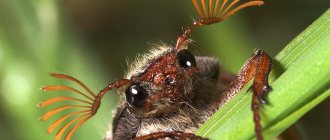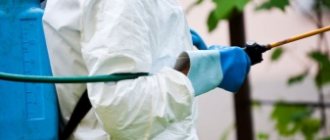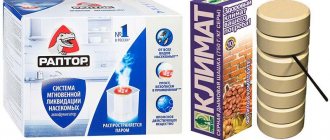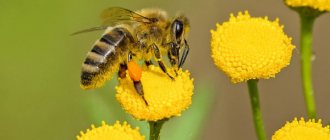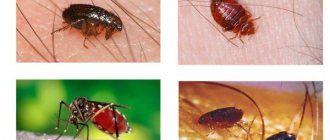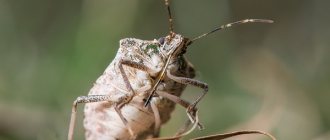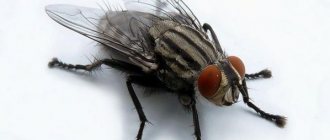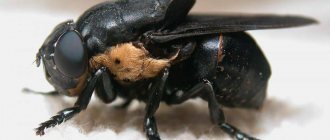People who are seriously and enthusiastically involved in gardening know examples of areas free from pests. In these areas, experienced and talented gardeners have created a biocenosis, a self-regulating system of natural balance. In this system, predatory insects, or entomophagous insects, play an important role, devouring insect pests. In an ordinary summer cottage, entomophagous insects are also able to significantly reduce the excesses of pests. In our article we will talk about the types of entomophagous insects, what pests they eat and how to lure them into the garden.
Beneficial insects - predators and beneficial insects - parasites
In nature, everything is interconnected: we plant plants that are food for herbivorous insect pests, and herbivorous pests are food for entomophagous insects. Entomophages are divided into two large groups: predators and parasites.
| Entomophagous insects | Interaction with pests |
| Predators | Larval and adult predators hunt pests, kill and devour them. |
| Parasites (parasitoids) | They lay eggs on or in the body of the pest, the larvae hatch and eat it. |
Both predators and parasites are in most cases pollinating insects. These insects are beneficial to the garden in every way. The first and most reliable sign that helps to distinguish garden pests from beneficial insects is low mobility. Pests move little and reluctantly; for the most part they sit on the plant and snack on it. Predators are nimble, they are constantly on the move, they hunt.
Amazing insects that look like leaves - leaf beetles, leaf beetles
These insects are called walking leaves, they have amazing mimicry - they look like leaves. This is one of the most amazing camouflages in the animal world. It belongs to the Phylliidae family.
Leaf insects take on the appearance of leaves. They reproduce the appearance of a leaf so accurately that predators often cannot distinguish them from real leaves. In some species, the edge of the insect's leaf body even shows signs of being bitten to further confuse predators. The leaf-shaped insect even sways back and forth, as if imitating a real leaf when the wind blows.
Scientist Antonio Pigafetta was the first to document this creature. He was on the team of Ferdinand Magellan's expedition around the world, studying and chronicling the fauna on the island of Chimbobon when the fleet went ashore for repairs. At this time he recorded the species of Phyllium in the following passage: On this island certain trees are found whose leaves, when they fall, come to life and walk. They look like mulberry leaves; their leaf is short and pointed, and near the stem there are two legs on each side. If you touch them, they run away, but if you crush them, they do not bleed. I kept one for nine days in a box. When I opened it, the leaf went around the box.
The 47-million-year-old fossil insect Eophyllium messelensis is a prehistoric ancestor of the Phylliidae, as it exhibits many of the same characteristics as modern leaf insects. This indicates that the family has changed little over time.
The "walking leaf" has more than 50 species of flat, usually green, insects (Phasmida) that are known for their striking resemblance to a regular leaf in appearance. Leaf-shaped insects live in dense vegetation and feed on plants.
Their natural range extends from islands in the Indian Ocean, from mainland South and Southeast Asia, to Papua New Guinea and Australia in the Western Pacific.
Leafworms have a body length of approximately 28 - 100 mm. Females are larger in body size than males. In addition, females usually have large anterior elytra (tagminae) that lie at the edge of the abdominal cavity. They tend to lack hind wings and generally do not fly. Males, on the contrary, fly - they have small front wings and non-leaf-shaped (sometimes transparent) hind wings. Females can reproduce (Parthenogenesis) in the absence of males. They move and drop eggs on the ground. The hatched young nymphs are wingless and brown or reddish. But as soon as they start feeding on leaves, their bodies turn green.
17 amazing facts about the unusual insect Mantis
How are wasps useful? Wasps Bees Bumblebees in the garden
Tarantula spider that eats huge birds
12 amazing facts about fireflies
The most common entomophagous insects
26 species of entomophagous insects have been registered in Russia, and they are used with great success in industrial horticulture and vegetable growing, and in greenhouses. In open ground, much smaller amounts of entomophages can be used, but they can protect plants from pests better than pesticides. Here are the most common and effective insects:
| Entomophage | What pests does it destroy? |
| ladybugs | Leaf aphids, oribatid aphids, spider mites, scale insects and false scale insects, psyllids, coccids, mites. |
| Gallica | Various types of aphids. |
| Ground beetle | Cutworm caterpillars, codling moths, moths, hawthorns, vegetable fly eggs. |
| hoverfly | Aphid |
| Rider | Butterfly caterpillars, fly larvae, aphids, apple moths. |
| Soft-bodied beetles (firefighters) | Various caterpillars, aphids, small slugs. |
| Pied beetles (beetles), (bee ants). | Bark beetles, longhorned beetles, grinders, weevils, etc. |
| Lacewing | Whitefly, aphids, etc. |
As you can see, there are no ants in this table. For them, aphids are a pet, which they care for like shepherds for a flock.
Polinka Moderator FORUMHOUSE
For ants, aphids are a natural cash cow, and the milk is the sweet “juice” that the gorged aphid secretes. To “milk” the ant, it is enough to tickle the aphid. The ants protect the aphids and transfer them to richer pastures (fresh plants) so that the aphids grow fat and provide milk to the ants. Bastards...
But we should dwell in more detail on the most common species of entomophagous insects in our latitudes.
ladybugs
The most common insect predators.
Here is a photo of a ladybug larva.
They look like microscopic crocodiles. Their color is remarkable: bright red or yellow spots on a dark background.
Unfortunately, many people confuse the eggs and larvae of the ladybug with the eggs and larvae of the Colorado potato beetle and mercilessly destroy them. But the larvae of the Coloradoan are almost perfectly round and pinkish. And the eggs of the pest are bright orange, while those of the ladybug are bright yellow. She lays them vertically to the surface of the leaf and is always close to aphid colonies.
By destroying the clutches and larvae of ladybugs, gardeners deprive themselves of excellent assistants in the fight against pests.
Nadanna Member of FORUMHOUSE
The larva is black and incomprehensible in appearance, like a booger. She also knows how to bite if she gets on your hand. And the already pupated one is motionless, red and looks like a Colorado larva. And they are such fools, everyone strives to pupate on potatoes, and the tricky thing comes to them, especially when in small plantings people manually collect.
During the larval phase, each ladybug eats about 1,200 aphids! An adult ladybug eats about 40 aphids per day.
Breeding Java Leafweeds
In insectariums, the parthenogenetic form is usually common, which means that females lay unfertilized eggs, and females hatch again after 4-6 months.
Newborn individuals have a red-brown color. Their body is wide and flat, so they disguise themselves as small leaves.
It’s simply amazing how the Kallima butterflies from the genus of day butterflies of the Lepidoptera family (Nymphalidae) can hide in plain sight. When the wings of the callima butterfly are folded, it looks like a dry leaf, hence the common name of the genus - leaf moth. Here is a striking example of mimicry in nature!
The resemblance of the butterfly to dry leaves is so realistic that even knowing that an insect is sitting on a branch, you won’t be able to see it right away. The color, shape, veins and shades, even the torn edges of a butterfly's wings completely imitate a dried leaf. In addition, to further resemble a dry leaf, the butterfly folds its wings in a certain way: the short outgrowths of the hind wings rest against the branch, as if it were a petiole.
But the inner surface of the wing of these camouflage masters has a bright metallic blue or rich blue color. And when she flies, and she flies quickly, she becomes very noticeable and beautiful. The beauty of the butterfly is also complemented by a wide orange or yellow stripe on the front wings. Some also have black tops with noticeable white spots.
These butterflies, which look like dry leaves, live mainly in tropical Asian regions, from India to Japan. Considered rare in China. Adults, depending on the species, have a wingspan of 45 to 90 mm. Callima have a lot of natural enemies: birds, ants, spiders, wasps, and some bacteria. They simply discourage birds with their behavior. One moment, butterflies seem to be fluttering, and a second later they are gone, simply dissolved among the foliage or stones.
Callima butterflies feed on plant sap and overripe fruits. They bear offspring twice a year - in the dry and wet seasons. The second generation has slightly smaller sizes and darker wing colors. Females and males are similar.
Mature females, after mating, lay eggs near large trees, boulders, or on host plants. The eggs have the shape of a green ball, on the surface of which there are a dozen vertical ridges. Newly hatched larvae are black in color and have spines on their bodies; at the final larval stage, the caterpillars become red. The pupa usually hangs on plant branches, has a brown background, and has sharp conical projections on each abdominal segment.
Leaves play a vital role in the survival of plants. They absorb sunlight and convert it into organic matter. Some plants, such as evergreen conifers and deciduous plants, retain their leaves throughout the year; others, like the oak, shed their leaves every autumn. Given the prevalence and importance of leaves in the world, it is not surprising that many animals camouflage themselves with leaves to protect themselves from predators.
Below are seven species of animals that look like plant leaves. Next time you pick up a leaf, make sure it's one and not one of those imposter leaves.
Ground beetles
This is what a ground beetle looks like: the color of the insect can be black or metallic.
Ground beetles are constantly on the move, chasing pests every minute of their lives. Over the summer, each ground beetle eats more than 300 caterpillars.
And this is what a ground beetle larva looks like.
They are black, shiny, with chest legs, also very nimble, moving surprisingly quickly. Gardeners often mistake them for pests and destroy them, thereby causing great damage to their garden. They hunt at night and try to hide during the day. During the day, each larva eats three times more pests than it weighs.
SergeyAnn FORUMHOUSE Member
The ground beetle is the most useful beetle. It does not harm the plant, on the contrary, it helps.
Pied beetles
With their shape and color, pied beetles resemble a bee or an ant, which is why they are called bee beetles or ant beetles.
This predator is invaluable for ornamental and fruit gardens, as it settles in trees and preys on bark beetles, borers and other dangerous pests. Their larvae live under the bark, move along the passages made by pests, and mercilessly destroy their larvae.
Prevention measures
Following the rules for caring for indoor flowers reduces the risk of pests. Each type of plant has its own standards for humidity, lighting, and fertilizing.
Basic Rules:
- optimal temperature conditions;
- watering according to the norm for a specific flower;
- sufficient sunlight or shade;
- regular loosening of the soil for active access of oxygen to the root system;
- fertilizer using organic components and synthetic preparations;
- regular inspection of all parts of the plant to identify pests and diseases;
- drainage system that prevents moisture stagnation;
- timely replanting of the flower if the flowerpot is too small;
- treatment with compounds based on natural ingredients to repel harmful insects;
- inspection of leaves, stems, soil when buying a new plant: often dangerous insects enter the apartment from a flower shop.
Pests of indoor flowers interfere with the normal development of plants, worsen the condition of buds, greenery, and root systems. Information about thrips, scale insects, mealybugs, and spider mites will help you understand how to recognize harmful bugs and mites, and how to deal with dangerous insects.
Mold, rot and small insects keep plants from living? The following video contains useful tips on how to solve the age-old problem and cure plants from pests and diseases:
The Java leaf beetle is one of the most unusual insects in the world, which surprises with its shape and protective coloring.
Javan leaf beetles belong to, they are common in the tropical forests of India, Mauritania, Borneo, Sri Lanka, Malacca, Java and Sumatra.
Lacewings
The lacewing is also probably familiar to everyone: it is a cute, ballet-like graceful green or beige insect that often lands on the windows of houses in the summer. They have a characteristic smell of mice, which scares away enemies from them.
Despite its innocent, angelic appearance, the lacewing is one of the most bloodthirsty predators. This is a nocturnal hunter; during the day it rests, and at nightfall it goes to deal with aphids. It is the lacewing that is artificially grown to protect plants in greenhouses, including rare plants in greenhouses.
Look at her face.
It is an incredible aggressor: one larva devours more than 500 adult aphids during its larval life; and one female lacewing lays more than 400 eggs!
Nadanna
Brown larvae can be seen in aphid plantings. This is a lacewing. She doesn't look very pretty and, of course, falls under attack.
Hoverflies
Hoverflies are valued both as entomophages and as excellent pollinators. A characteristic feature of these flies: during flight they do not buzz like others; the sound that is heard when their wings move is reminiscent of the murmur of water.
Predatory species of hoverflies lay eggs directly into aphid colonies. There are several hundred eggs in one clutch, and one larva can eat from 500 to two thousand aphids.
External description of the leaf butterfly
When the leaf butterfly's wings are folded, it is practically indistinguishable in appearance from a dry leaf.
It was thanks to this similarity that the common name of the genus appeared - leafweed. It is leaf butterflies (callimas) that are perhaps the most illustrative example of mimicry in nature.
The leaf butterfly is so similar to a dried leaf that even a specialist who is well acquainted with this insect, stroking the branch where this insect sits and, knowing that it is sitting there, cannot immediately distinguish it. The shape, color, shades and veins of the wings of the Kalima completely, in the smallest detail, imitate a dry leaf.
Surprisingly, even the edges of the wings of the leaf butterfly look torn and frayed, like a dry leaf. However, the similarity with a dry leaf does not end there: in order to achieve maximum resemblance to a dried leaf, the kalima folds its wings in such a way that the hind wings, with their short outgrowths, rest against the branch, as if it were a petiole.
As for the inner surface of the wings of these camouflage geniuses, it has a rich blue color or a bright metallic blue. Leaf butterflies fly quite quickly and, thanks to such a specific coloring, during flight they become very beautiful and noticeable.
The beauty of the leaf butterfly is complemented by a wide yellow or orange stripe located on the front wings. Some butterflies also have black tops with white spots clearly visible against a black background.
Plants
In many entomophages, larvae feed on pests, and adult insects eat nectar (some eat both nectar and pests). Therefore, entomophages choose to live in places where honey plants, umbellifers and cruciferous plants with small flowers grow.
The best plants to attract entomophages:
- dill;
- parsley;
- clover;
- onion;
- caraway;
- parsnip;
- carrot;
- oregano;
- St. John's wort;
- celery,
- sunflower;
- buckwheat;
- Vika;
- Tartar;
- tansy.
- daisies; daisies, marigolds (attract hoverflies).
These plants are planted along the edges of flower beds and tree trunks, forming flowering borders from them. It is advisable to plant plants so that they bloom, replacing each other, or give preference to those that bloom for a long time (basil, oregano, rosemary, hyssop, etc.)
Shelters
Some entomophagous insects willingly settle in artificial shelters that gardeners make for them. For ground beetles, bricks, flat stones or pieces of plywood are laid out around the area, which are installed so that one end is raised above the ground by 1-1.5 cm. In these dugouts, the ground beetles will wait out the daytime, and at night they will crawl out on patrol to protect the garden frontiers.
To attract lacewings and some other entomophages, flower pots with drainage holes (bottom up) are hung on tree branches and filled with hay or simply dried grass. The hay is changed every spring.
In some areas of the garden it is recommended not to mow the grass. In such overgrown corners, where a layer of grass, leaves, etc. is created, entomophages settle for the winter.
Wednesday
Different types of entomophages require different conditions.
| Entomophages | Attractive environment |
| Ground beetles | Moist shaded areas, tall grass next to bushes and trees. From these dark corners, ground beetles go out at night to hunt flower beds and flower beds. |
| Hoverflies | It is extremely important to have early flowering plants in the garden, such as coltsfoot and even the weedy dandelion. The sooner they find nectar, the sooner the larvae will appear. If there is no nectar in the spring, larvae may not be expected until August. |
| Lacewings | Thickets of ferns, evergreen shrubs and other cool places in partial shade where lacewings lay their eggs. |
FORUMHOUSE has many supporters of organic farming who prefer to collaborate with nature, including beneficial insects. Read our article about permaculture: a method in which plants are planted to help each other grow and protect themselves from pests. Watch our video with an overview of new products for gardening.
Reproduction of leaf butterflies
The leaf butterfly brings offspring twice a year: once in the wet season and a second time in the dry season.
The generation born in the wet season is somewhat smaller in size and darker in coloration of the wings. Sexual dimorphism is not expressed and females and males practically do not differ from each other.
After mating, mature females lay eggs near large trees, boulders, and on host plants. Externally, the eggs of the leaf butterfly look like a green ball. Ten vertical ribs can be seen on its surface. Larvae that have just hatched from eggs are black in color and have spines on their bodies. At the final larval stage, the caterpillar becomes red instead of black. As a rule, the pupa hangs on thin branches of plants, is colored brown, and has sharp conical protrusions on each abdominal segment.
How to recognize pests on indoor plants? How to deal with bugs, spiders and mites? Experienced flower growers recommend proven methods of dealing with uninvited “guests”.
